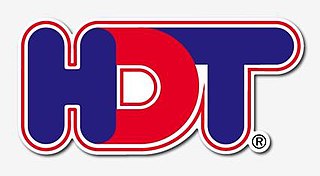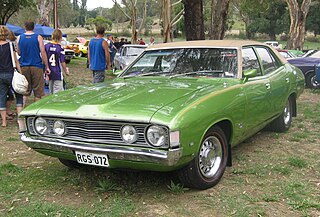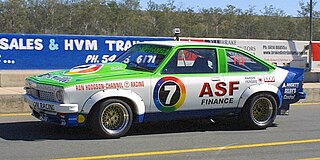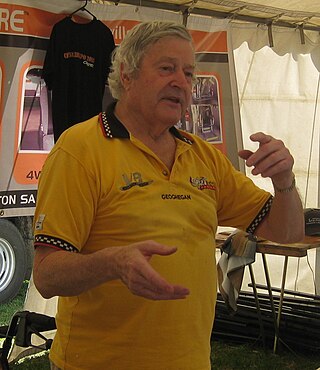The Australian Touring Car Championship (ATCC) is a touring car racing award held in Australia since 1960. The series itself is no longer contested, but the title lives on, with the winner of the Repco Supercars Championship awarded the trophy and title of Australian Touring Car Champion.

The Holden Dealer Team (HDT) was Holden's semi-official racing team from 1969 until 1986, primarily contesting Australian Touring Car events but also rallying, rallycross and Sports Sedan races during the 1970s. From 1980 the Holden Dealer Team, by then under the ownership of Peter Brock, diversified into producing modified road-going Commodores and other Holden cars for selected dealers via HDT Special Vehicles.
Allan George MoffatOBE is a Canadian-born Australian racing driver known for his four championships in the Australian Touring Car Championship, six wins in the Sandown 500 and his four wins in the Bathurst 500/1000. Moffat was inducted into the V8 Supercars Hall of Fame in 1999.
John GossOAM is an Australian retired motor racing driver who competed in his home country during the 1960s, 1970's and 1980's. He is the only driver to have won Australia's two most prestigious races, the Bathurst 1000, and the Australian Grand Prix (1976).

The Ford Falcon (XY) is a full-size car produced by Ford Australia from 1970 to 1972. It was the fourth and last iteration of the second generation of the Falcon and included the Ford Fairmont (XY)—the luxury-oriented version.

The Ford Falcon (XA) is a full-size car that was produced by Ford Australia from 1972 to 1973. It was the first iteration of the third generation of the Falcon and also included the Ford Fairmont (XA)—the luxury-oriented version. The XA platform was also used for the Australian Ford Landau.
The 1970 Australian Touring Car Championship was a CAMS-sanctioned motor racing title for drivers of Group C Improved Production Touring Cars and Group E Series Production Touring Cars. The title, which was the 11th Australian Touring Car Championship, began at Calder Park Raceway on 22 March 1970 and ended at Symmons Plains Raceway on 15 November after seven heats.

In relation to Australian motorsport, Group C refers to either of two sets of regulations devised by the Confederation of Australian Motor Sport (CAMS) for use in Australian Touring Car Racing from 1965 to 1984. These are not to be confused with the FIA's Group C sports car regulations, used from 1982 to 1992 for the World Endurance Championship / World Sports-Prototype Championship / World Sportscar Championship and the 24 Hours of Le Mans.
The Ford works team was the unofficial name for an Australian motor racing team which was supported by the Ford Motor Company of Australia. The team was formed in 1962 and was disbanded when Ford Australia withdrew from motor racing at the end of 1973. Drivers for the works team included Allan Moffat, Fred Gibson, Harry Firth, Bob Jane, Barry Seton, Bruce McPhee, John French, Ian Geoghegan and his brother Leo Geoghegan. Ford Australia also supported a factory rally team in Australia from 1977 to 1980.

The 1973 Hardie-Ferodo 1000 was the 14th running of the Bathurst 1000 touring car race. This was the first race to be held under the new metricised distance of 1000 kilometres, rather than the 500 miles previously contested. It was held on 30 September 1973 at the Mount Panorama Circuit just outside Bathurst in New South Wales, Australia. The race was open to Group C Touring Cars competing in four engine capacity based classes. It was the third round of the 1973 Australian Manufacturers' Championship.

The 1972 Hardie-Ferodo 500 was an endurance motor race open to Group E Series Production Touring Cars. The race was held on 1 October 1972 at the Mount Panorama Circuit just outside Bathurst in New South Wales, Australia. Cars competed in four classes defined by Capacity Price Units, where the engine capacity, expressed in litres, was multiplied by the purchase price in Australian dollars to arrive at a CP value for each vehicle. It was the 13th running of the Bathurst 500 race and the last to be held over the original distance of 500 miles. It was also the last to allow drivers to compete for the full distance without a relief driver. The race was the third round of the 1972 Australian Manufacturers' Championship.

The 1971 Hardie-Ferodo 500 was a motor race held on 3 October 1971 at the Mount Panorama Circuit just outside Bathurst in New South Wales, Australia. It was open to production vehicles competing in showroom condition, with the field divided into five classes based on the purchase price of the vehicle in Australian dollars. Although an outright winner was officially recognised, all other official awards were for class results only. The race was the 12th in a sequence of annual "Bathurst 500" production car races dating back to the 1960 Armstrong 500. The outright winner was Allan Moffat driving a Ford XY Falcon GT-HO Phase III.

The 1969 Hardie-Ferodo 500 was the tenth running of the Bathurst 500 production car race. It was held on 5 October 1969 at the Mount Panorama Circuit just outside Bathurst in New South Wales, Australia. Cars competed in five classes based on purchase price of the vehicle.
The 1984 Australian Touring Car Championship was a motor racing competition for Group C Touring Cars. The Championship was authorised by the Confederation of Australian Motor Sport as an Australian National Title. It was the 25th Australian Touring Car Championship, and the last to be contested by Group C cars as new regulations, based on international Group A, were introduced for 1985.
The 1972 Australian Touring Car Championship was a CAMS sanctioned national motor racing title open to Group C Improved Production Touring Cars and Group E Series Production Touring Cars. The championship, which was the 13th running of the Australian Touring Car Championship, began at Symmons Plains and ended at Oran Park after eight rounds.
John French is an Australian retired racing driver.

Leo Geoghegan was an Australian former racing driver. He was the elder of two sons of former New South Wales car dealer Tom Geoghegan, both of whom become dominant names in Australian motor racing in the 1960s. While his younger brother Ian "Pete" Geoghegan had much of his success in touring car racing, winning five Australian Touring Car Championships, Leo spent most of his racing career in open wheel racing cars.

The Ford Falcon GT is an automobile produced by Ford Australia from 1967 until 1976 as the performance version of its Falcon model range. Its production was resumed by a joint venture in 1992 and 1997 with Tickford, and then again between 2003 and 2014 with Prodrive, the latter being marketed as the FPV GT & GT-P. The Falcon GT is inextricably linked with the history of Australian sports sedan car production and with the evolution of Australian motor racing.The Falcon GT lineage includes many Bathurst wins and motorsport accolades over its entire production run.
Allan Moffat Racing was an Australian motor racing team owned by multiple-championship winning Canadian-Australian racing driver Allan Moffat. The team was highly successful, winning races on three continents including three Australian Touring Car Championships in 1976, 1977 and 1983, four Bathurst 500/1000s including a memorable 1–2 victory in 1977, and the 1987 Monza 500, which was the inaugural race of the World Touring Car Championship.
The Supercar scare was a national controversy that arose in Australia in 1972 in regard to the sale to the public of high performance "homologation special" versions of Australian-built passenger cars.








